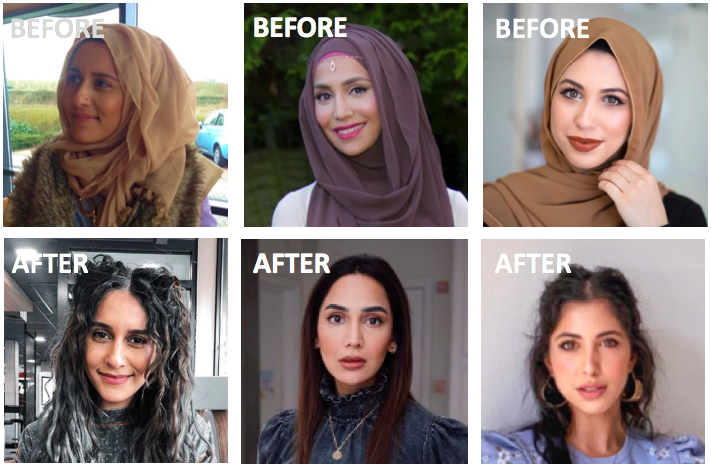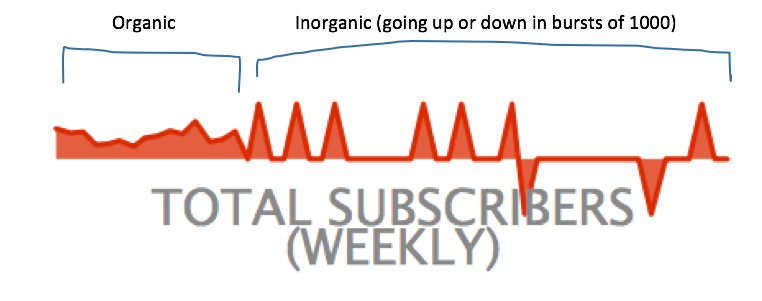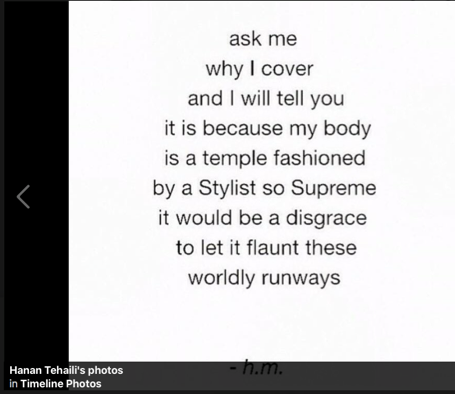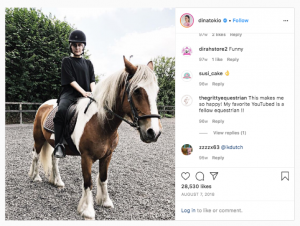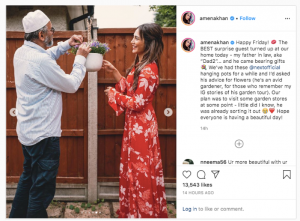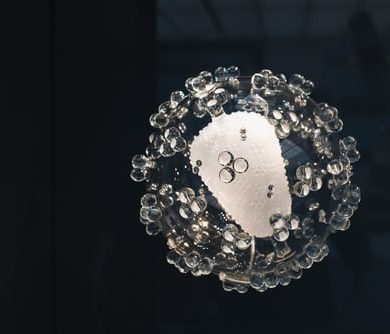Top image left to right: Dina Tokio, Amena Khan, Hanan Tehaili
(CLICK HERE to read Kalima Institute’s statement on this article)
Hijabi influencers have been around for at least a decade and have been teaching young Muslim girls and women all about how to wear their hijabs in a stylish way, how to dress ‘modestly’ and how to pull off the latest make-up look. Three of these influencers will be discussed in this article – Dina Tokio (1.3 million followers on Instagram), Amena Khan (644k followers) and Hanan Tehaili (433k followers). In some ways there has been a benefit – Muslim women who have never worn the hijab and new reverts learned how to wear one, some were inspired to wear the hijab because of them, and they did teach many how to look for ‘modest’ items in mainstream shops especially in the West where hijab-specific clothing is hard to come by. However, this has also led to a degeneration of the meaning of hijab as it became desacralized and merely a fashion piece.
The Rise of the Hijabi Influencers
Capitalism, consumerism, and celebrity culture – three forces which shape the way people think and behave. They are tools used to influence and coerce the population to do what those in power desire. Islam, which opposes these very forces has become the target. As one of the most visible symbols of Islam, Muslim women in their hijab have been one of the areas hardest hit. Muslim women have been attacked for wearing the hijab for decades. The hijab has been described as an act of oppression and something that Muslim women need to be liberated from. It has also been seen as something that is worn only by women who are weak, submissive and who lack a sense of fashion. In order to fight back against this notion and to prove that they are empowered and can look good in a hijab, many Muslim women took to the internet to share their perspectives. Due to this, along with the rise of social media, the hijabi [1] influencer was born.
A new and worrying trend however, is that those pioneering hijabi influencers who have millions of followers are now one by one – taking off the headscarf – the same headscarf they built their careers off. This has caused many of their followers to become disheartened and confused, feeling like they hace been lied to and betrayed. While others, indoctrinated by the mantra of ‘you do you’, hurry to hush the critisisers and tell them to ‘stop judging because only Allah can judge’.
So how can we make sense of this situation?
Here are four things to keep in mind:
1. It is INTENTIONAL
It’s in the name; they are influencers. They are very aware that their actions and choices influence their viewers. That’s why companies are willing to pay thousands of $$$$ to get them to use their products. So when these hijabi YouTubers take off their hijab, they surely know that they may be influencing you to do the same.
We may think we have control over our actions, but much of what we do is based on the environment we live in, what we see around us, our family, friends and so on. This is called the phenomenon of ‘social contagion’ where people are more likely to do things if they see others around them doing it. There is a science to influence and those who want you to take off your hijab know exactly how to do it. It operates on a subconscious level:
In a subtle fashion, social networks help spread contagions; create “epidemics” of obesity, smoking and substance abuse, disseminate fads and markets, alter voting patterns, and more” [2].
We are literally witnessing the epidemic of hijab-removal.
According to entrepreneur Andrew Molz:
Industry influencers in niches such as fashion and beauty hold a lot of sway over [millennials]… they start trends, determine what’s cool and desirable, and curate the must-have items as fashion magazines used to do.”[3]
These influencers are immensely influential and those in power know it and capitalise on this. Followers who go on to remove their hijab, are not being empowered to make this ‘choice’, they are simply falling in the trap set up for them. The conclusion here is that if you are one who follows or watches the content of these misguiding influencers, stop now if you want to safeguard your faith.
2. They are brands, not people
Influencers often build a deep relationship with their viewers to the point that people feel like they’re the ‘sisters they never had’ or one of their close friends. They trust that person’s advice and feel they truly know them. Seeing that person’s day-to-day life through vlogs and getting to know the person through long conversation-style videos and personal Q&A’s, it’s no wonder viewers feel this way.
But we have to keep in mind that this is a business. You don’t know them as a person. You know them as a brand. Dina Tokio. Amena. Hanan Tehailli. These are brands. What you see is a carefully curated portrayal. And don’t forget that these influencers often have agents and a whole social media management team who help them manage their business.
Dina Tokio used to sell hijabs and modest clothing, she sold a book called Modestly right before she took off her hijab publicly. Amena Khan still sells hijabs on her website Pearl Daisy. Hanan Tehailli used to call her brand Hijabs by Hanan and used to be a hijab stylist and sold hijabs. All of them started off their careers by doing hijab tutorials and it was this that enabled their business to grow and provided many opportunities for them. We would think that in this case, their business would be severely impacted by them removing the hijab. But intriguingly, this is not the case.
Since they are brands and make a living purely from their social media presence, they would not have taken off their hijabs if they knew it would impact their full-time career and source of income. There are other things happening behind the scenes. If we examine the statistics of their subscribers, we find suspicious data. For example, the number of Hanan Tehaili’s subscribers goes from organic growth to inorganic growth which is quite questionable (fig 1).
At the end of the day, we all need to remind ourselves that influencers are not really our friends and they don’t necessarily want what’s best for us. They have their own interests in mind (be they hijabi or not).
3. There is a Hidden Agenda Behind it: Secularisation
Secularisaton is defined as the transformation of a society from closely identifying with religious values and moving them towards nonreligious values. In a nutshell, it is about separating religion from the public sphere so that religious symbols are completely erased. If you track these ex-hijabi influencers from when they first started their blogs until now, you will see a subtle but obvious transformation due to this secularisation process. For example, Amena Khan, the influencer who most recently took off her hijab, used to start off her videos saying “assalmualaikum my lovelies” to now saying just “hi lovelies”. Dina Tokio used to say words such as alhamdulilah and even used to mention God a few times. They used to be proud of their hijab (see fig. 2). Noticeably, this has now dwindled to almost nothing.
Dina Tokio, the first of the popular hijabi influencers to take off her hijab, used to have a video a few years back in which she said something along the lines of: I’ve worn the hijab every day since the age of 11 and have never taken it off a single day I’ve gone outside… I’ve had struggles but what keeps it on me is my faith in God. If God wasn’t in the picture the hijab would have been off my head a long time ago (paraphrased as the original video has been removed). In the words of Dina herself, the removal of the hijab is an indication of a weaker faith in Allah (swt). Dina Tokio should have reiterated the same concept to explain why she took off the hijab instead of giving no explanation and leaving her fans confused. To make matters worse, two months after announcing the removal of her hijab, Dina released new merchandise branded “I like me, so you don’t have to”. This statement sends a clear message: “it doesn’t matter if you disagree with what I’ve done or if I’ve disobeyed God, I’m happy with my choice and that’s all that matters”. The underlying theme here is rebellion against the laws of Allah and worshipping the self. This is the consequence of secularisation. Self-love has turned into self-worship.
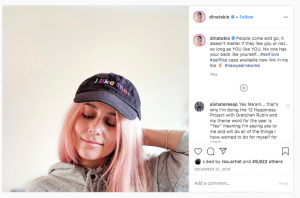
Figure 3 Dina Tokio promoting her ‘I Like Me’ merchandise. Caption reads: “People come and go, it doesn’t matter if they like you or not.. so long as YOU like YOU. No one has your back like yourself.”
She might like herself, but has she thought about if Allah (swt) likes her? As Muslims, we must submit to Allah our Creator fully. What matters is obeying and worshipping Him, not our desires. He is the One who owns us and we will certainly return to Him. Our final destiny and happiness is determined by our closeness to Him. By taking off the hijab, she has committed a serious sin publicly and how can anyone be proud of a sin? These damaging ideas are presented subtly under the guise of merchandise, but are unimaginably dangerous to her audience, especially young Muslim girls. Allah is at the beginning and end of everything we do, and His pleasure is the compass by which we should direct our lives. If something displeases Him, we must steer clear away from it and feel shame, not pride. Secularisation contradicts our human fitra (innate nature) and we will never feel internal peace until we build firm faith in our hearts.
الَّذِينَ آمَنُوا وَتَطْمَئِنُّ قُلُوبُهُم بِذِكْرِ اللَّهِ ۗ أَلَا بِذِكْرِ اللَّهِ تَطْمَئِنُّ الْقُلُوبُ – 13:28
The ones who believe and their hearts are peaceful with the remembrance of Allah. Listen, the hearts find peace only in the remembrance of Allah.”
4. They are Gaslighting and Manipulating You
“When I saw you left the hijab it hurt my heart.”
“I cried seeing you removed your hijab.may Allah guide you”
– Comments left on Hanan Tehaili’s Instagram posts after she took off her hijab.
These influencers have tried to convince their audience for years that they are a close friend, yet a true friend is honest and caring of your feelings. After years, even decades, of being on social media as ‘hijabis’, these social media influencers try to make it look like no one has the right to oppose them taking off the hijab or to feel upset about it. In an ideal situation, these influencers would publicly announce that removing the hijab is a deterioration in faith and they need to disappear from the social media scene until they come to terms with the struggles they are having in their personal lives. They must be clear that they do not want to encourage their audience to follow in their footsteps which cannot be done if they continue to bombard their followers with pictures of themselves.
If someone objects or simply expresses disappointment (especially through the comment section on YouTube and Instagram), they are considered a toxic, negative person who is a ‘haram police’ and should stop judging others, when in actual fact, many commenters are genuine and truly feeling hurt. Dina Tokio even went as far as calling the hijabi Muslim community a ‘toxic cult’ for criticising her. However, this is simply to gaslight her audience and make herself the victim. There is nothing inherently wrong with the hijabi Muslim community – the same amount of backlash would have happened for any other influencer that suddenly goes against what they stand for. For example, if a popular vegan influencer suddenly starts posting recipes with meat in it, the followers of that page are going to be confused, object, and would ask why.
Influencers such as Dina, Hanan and Amena give very vague reasons for removing the hijab. Dina Tokio, after removing the hijab confessed that she “[hasn’t] considered [her]self as a hijabi for years”[5]. Why then did she continue to portray herself as a hijabi YouTuber, even selling hijabs and being a representative of hijabis at events and marketing campaigns? For example, she was interviewed by Times Magazine on August 25, 2018, two months before taking off the hijab and was representing Muslim hijabis, even commenting about the burka[6]. At this point she had already taken off the hijab but hadn’t done it obviously. This picture, posted on August 7, 2018, 18 days before the interview was published, shows Dina wearing a helmet and no hijab (fig. 4). A vlog of that day also confirms that she was not wearing hijab at that point. This is extremely dishonest and people have a right to be hurt by this.
Further, they try to manipulate the reality behind removing the hijab, which is a major sin and goes against the commandments of Allah, by strategically using terms such as ‘change’, ‘self growth’ (fig. 5), ‘authenticity’, or ‘new season in my life’.
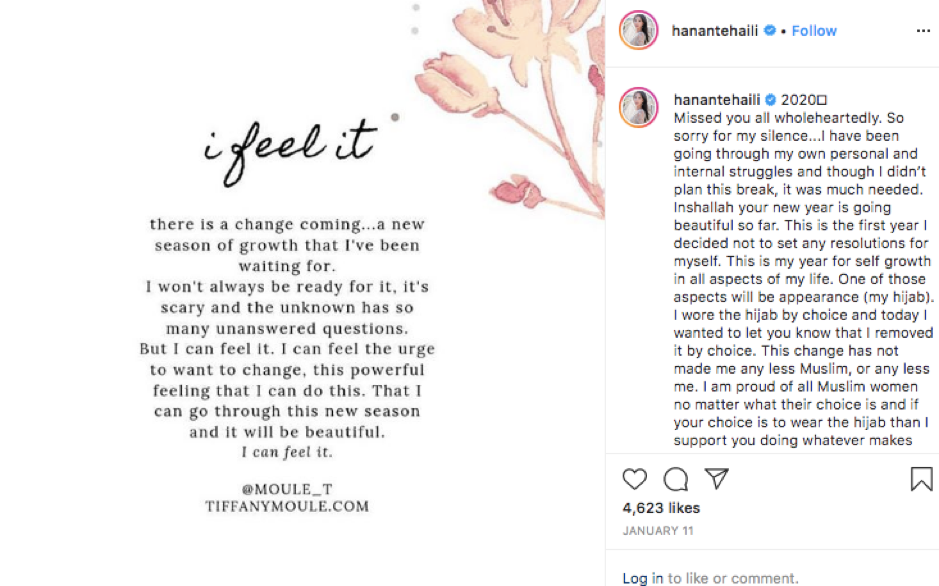
Figure 5 Hanan Tehaili’s announcement on removing her hijab uses manipulative terms such as ‘self growth’
The Hijabi Bengali Sisters made an honest video on YouTube describing what Amena and the like have done to their followers: “You trust them, support them and support their business, but then when they do something that hurts you they turn it around on you and say you’re ‘judging’ them, and that it’s not a big deal. This makes you feel like a crazy person, like you don’t have the right to think in this way”[8]. This kind of manipulation is essentially gaslighting. They also rightly assert in the video: “We have the right to be upset, we have the right to disagree, we have the right to express our disappointment”.
There is no excuse for followers to be rude, but to censor and delete any criticism is deceptive. Moreover, many people have noted that they wrote very polite comments that were still deleted, such as this sister:
“I posted a very kind comment on her [Amena’s] Instagram, addressed to young sisters, but she deleted it. I said I love the dear sister Amena and have followed her for over a decade. But, I want them all to know that the only reason to remove your hijab is a disconnect with Allah swt. If you are struggling with your Islam, you should hang on to your hijab with dear life.”[9]
Another technique used by these popular ex-hijabi influencers is to bombard viewers right after taking their hijab off with pictures of them with big smiles and captions like “lovely summer day!”, to show that taking the hijab off is no big deal, and deceivingly, that it made them happy. It will be a big deal on the Day of Judgment and on that day these vague excuses will not be justifiable. For example, Amena posted this picture (fig.6) shortly after taking off the hijab as if to say “my life could not be better, my family did not oppose me, they are giving me flowers for taking off the hijab. If you are thinking of taking it off, don’t worry there will be way less backlash than you think”.
To be sincere and ‘authentic’ like they claim to be, they have to acknowledge that they have lost their faith in Allah because if your faith is strong and you truly believed in the Day of Judgement in your heart, you would never publicly advocate sinning against Him as you would know what the consequences of that would be. They don’t need more sins in their basket. Ultimately, it is up to us to be aware of the manipulative techniques that are being used so that we can protect ourselves from falling into this deception. And we should not be bullied into silence.
Conclusion:
Hijabis have been attacked from all angles for wearing the hijab, and what better way of attributing the final blow than getting us from the inside. There is undoubtedly a conscious plan devised to weaken the Muslim Ummah, and these influencers are being used to serve this purpose. If they can get the very people who have inspired many to wear the hijab and are literally the icons of hijab in the social media world to take it off, they know they will hit the vulnerable in our community. They will use endless forms of manipulation to make this happen.
However, what is certain is that they will never win. And the light of Islam will remain a shining light in our darkening world. This plan will surely backfire and in the long run, we will see more Muslimahs putting on the hijab and holding tight to it. Our role is to strengthen our imaan and our relationship with Allah, while keeping our eyes wide open so we don’t fall into the traps set for us.
These ex-hijabis are truly the unlucky ones for they may be posting bright pictures with wide smiles, they trivialise their sins and have lost God’s love:
When God loves a person, He makes this person’s sin appear great and opens to him the door of repentance. This door opens to the gardens of intimacy with God. And when He becomes angry with a person. He makes his sins appear very small in that person’s eyes and He punishes him with a variety of calamities; but because the person is unfortunate enough to see his sins as small, he does not take advice and the result is frustrations and disappointment. [10]
We must remember that our relationship with Allah is the most important thing in this life and when we lose Him, we lose everything. The only way to attain true happiness in this life and the hereafter is to worship Him instead of following our desires and obey His commandments which do not benefit Him but us.
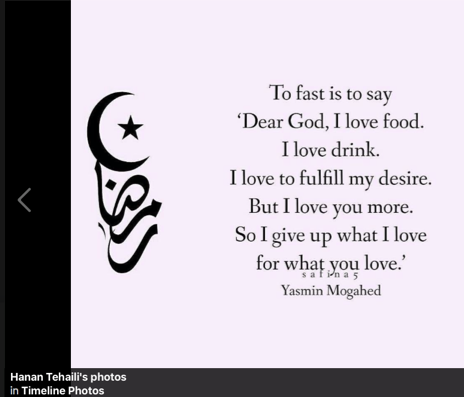
Figure 7 “I give up what I love for what you love”. Quote from Hanan Tehaili’s Facebook page a few years ago, a reminder to her and us all.
By Naba Alsaffar
References
[1] Hijab, in this article, refers to the headscarf worn by Muslim women. Hijabis refers to those who wear the hijab.
[2] Source: https://searchengineland.com/how-social-media-is-influencing-your-behavior-40615
[3] Source: https://www.forbes.com/sites/andrewarnold/2017/12/22/4-ways-social-media-influences-millennials-purchasing-decisions/
[5] Dinatokio Drama, podcast posted on Dina Tokio’s youtube channel: https://www.youtube.com/watch?v=xHKzkvcKAZM
[6] Link to article: https://www.thetimes.co.uk/article/dina-torkia-interview-the-muslim-fashion-blogger-talks-boris-johnson-and-burkas-k62mz6bv6
[8] Hijabi Bengali Sisters unfortunately put this video on private.
[9] This comment was posted under the Hijabi Bengali Sisters’ video which is now on private.
[10] Brodbeck, R. C. (2011, p. 247). From the Stage to the Prayer Mat. Tughra Books.
List of Figures
Figure 1. Social Blade. Total Weekly Subscribers Graph. Retrieved 2020, June 1, from: https://socialblade.com/youtube/user/hijabsbyhanan
Figure 2. Tehaili, Hanan. (2015, July 20). #MondayMotivation ✨. [Facebook post]. Retrieved from https://www.facebook.com/hanantehaili/photos/a.594425147286408/1020970757965176/?type=3&theater
Figure 3. Torkia, Dina [@dinatokio]. (2018, December 31) People come and go, it doesn’t matter if they like you or not.. so long as YOU like YOU. No one has your back like yourself. [Instagram post]. Retrieved from https://www.instagram.com/p/BsA7ejlFJv6/
Figure 4. Torkia, Dina [@dinatokio]. (2018, August 7). Heres another new lil man in the family. [Instagram post]. Retrieved from https://www.instagram.com/p/BmJCGA3AGZs/
Figure 5. Tehaili, Hanan [@hanantehaili]. (2020, January 11). Hijab removal announcement. [Instagram post]. Retrieved from https://www.instagram.com/p/B7Kfca2JZ1l/
Figure 6. Khan, Amena [@amenakhan]. (2020, June 13). Happy Friday! [Instagram post]. Retrieved from https://www.instagram.com/p/CBVqh7lHYlf/
Figure 7. Tehaili, Hanan. (2015, July 9). This is beautifully said. I can’t believe only one more week to go!!! Alhamdulilah it’s been an easy month by far! Allah really gave me strength. [Facebook post]. Retrieved from https://www.facebook.com/hanantehaili/photos/a.594425147286408/1009439825784936/?type=3&theater


